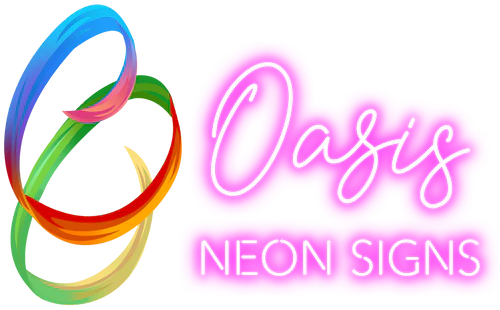
How Long Do Neon Signs Last?
Share
Neon signs have long evoked vibrant nightlife, retro aesthetics, and festive advertising. Whether illuminating a business's storefront or turning homes into a gallery of nostalgic charm, these luminous signs evoke nostalgia and charm. However, one of the main concerns of potential buyers has been the longevity of a neon sign. Knowing how long neon signs are good for and what plays a role in their longevity would allow for a more informed decision when investing in one.
Average Life Span of Neon Signs
If built well, neon signs last from 8 to 15 years, depending on the quality of maintenance, their usage, and perhaps the environmental conditions. Moreover, some top-grade neon signs have been known to last beyond 20 years when well taken care of. However, operating conditions such as running 24 hours a day, deposition of corrosive salts and dirt, exposure to fluctuating temperatures, poor mounting, and low-quality maintenance can considerably shorten their lives.
Factors Affecting the Lifespan of Neon Signs
Neon signs do not just fail overnight. The lifespan of a neon sign is explained by the combination of material quality, exposure to the surroundings, electrical supply, and maintenance. Here are the crucial elements capable of influencing their lifespan:
1. Quality of Materials and Build
Every neon sign is not the same. The materials used, i.e., glass tubing, electrodes, and transformers, are important factors that help to determine how long the sign will last. Neglect or bad workmanship in its construction will lead to more wear and tear and frequent repairs and replacements.
Whereas premium, high-quality neon signs use durable glass tubing and quality phosphor coatings for a longer life. An artfully crafted neon sign, such as a professional bend of the tubes and proper assembly of the sign into its casing, will mean better performance and durability.
2. Frequency and Duration of Use
The frequency of the use will also determine the lifespan of your neon sign. A neon sign that is working day and night will give in much sooner than one that works for some hours every day. Many businesses use timers to make sure the sign is turned off when it is not needed will help with longevity.
For example:
- A neon sign that runs 12 hours a night can last about 15 years.
- A neon sign that is left on 24/7 can burn out in 8-10 years.
3. Quality of Power Supply and Transformer
Neon signs are powered by high-voltage transformers. A high-quality transformer that has been maintained will smooth the power supply and allow for steadier lighting. But cheap or defective transformers will cause voltage fluctuations, leading to flickering, dimming, or a failure too soon.
4. Environmental Conditions and Placement
Your placement of a neon sign will also determine how long it stays on. Signs placed outdoors fall prey to harsh weather conditions, such as rain, extreme temperatures, and pressure conditions that can detract from their long-term operation.
Outdoor neon signs require weatherproofing, protective casings, or covers that minimize moisture damage. Because indoor neon signs are sheltered from severe weather, the lifespan of neon signs installed indoors is longer.
5. Good Maintenance and Cleaning
It is very beneficial to regularly maintain neon signs, as this would make the neon sign last longer. Accumulation of dust, dirt, and grime results in the dimming of the neon signs due to the covering of the glass tubing of neon signs.
Cleaning Dust: For the glass tubes, use a soft, dry rag or a duster to remove all dust. Tough stains can be sprayed with mild soap and water, but keep moisture away from the electrical component.
Periodic Inspection: Look for cracks, loose wiring, or flickering lights that may indicate repairs to individual components.
Signs of degradation of your neon sign color
Over time, neon signs become functional. These are a few of the usually known signals of a neon sign heading past its time:
1. Fluctuating or fading
Dimming or blinking of a neon sign could mean that the gas is running out, the transformer is faulty, or the electrical connection is not perfect—all of which would imply the end of its useful life. Although small hiccups can sometimes be easily fixed, persistent flickering sadly suggests the neon sign could be on its end.
2. Alterations in colour
Either neon or argon makes up neon lights. Either leaks or damage would cause the signal to produce unintended colors. Bright red neon will start to fade to an orange or even pink tint when the gas is enough depleted.
3. Vibrating or singing
If the neon signs are in good shape, they should work silently. Buzzing or humming noises could be evidence of an electrical problem or a defective transformer.
4. Cracked or Split Tubes
Made of delicate glass tubes that can break from hasty contact, mishandling, or environmental events, these lovely neon signs with a soft glow are slightly delicate. Once a tube breaks, the sign stops working and the gas gets out.
Ways to enhance the lifespan of neon signs

Improving the life of neon signs follows some basic criteria:
1. Turn off if not in use
To avoid undue wear, please turn off the neon sign as often as possible. Using a timer or a dimmer switch helps you manage its working hours.
2. Maintain it clean
Cleaning glass tubes regularly will prevent dirt from building up and blocking the advance of light. Do not use substances or solvents that could damage your surfaces. Check out this detailed blog about cleaning neon signs to learn the most effective ways to keep your sign looking bright and new for years to come.
3. Defend from heat and dampness
When exposed to natural elements including rain and moisture, an awning or enclosure should protect the neon sign.
4. Right installation
A neon sign can put less stress on the electrical grid if it is correctly installed. To guarantee safe wiring and security, always hire a qualified installer.
Sustainability and Future of Neon Signs

As the development of technology cruises forward, neon signs' future becomes ever more certain. While traditional neon signs have attained an iconic status in advertisement and decoration, energy consumption and environmental impact have prompted alternative lighting solutions. Neon signs and advertisements usually require high-voltage transformers, which makes them consume much electricity compared to LED alternatives. This makes businesses and people look for energy-efficient alternatives while keeping the antique feeling of a neon light overhead.
Now, manufacturers are producing eco-friendly neon solutions that have modern gas compositions and more powerful electrical supply systems. Other companies are also working on hybrid neon-LED designs that reproduce the original neon glow while consuming less energy and using much less care. Programs to recycle both glass tubes and neon gas for the disposal of old neon signs are also being put into practice today to make it a more sustainable disposal process.
Neon signs, on the other hand, are still the sign of choice among people who like fine aesthetics and workmanship. Unfortunately, the main factor that will be used to verify that proper condition and care along with responsible usage and innovation in manufacturing techniques will keep these neon signs alive that an individual appreciates will be sustainability. Thus, even as sustainability initiatives stretch thin across the land, neon signs will probably always hang in cities, combining culture and modernity for years to come.
Longevity Comparison between LED Signs and Neon Signs
Some buyers view LED signs as an alternative to their classic neon signage. Here’s a quick comparison in terms of lifespan:
|
Feature |
Neon Signs |
LED Signs |
|
Lifespan |
8-15 years |
50,000+ hours |
|
Maintenance |
Periodic cleaning and gas refilling are needed. |
Minimal maintenance required |
|
Durability |
Fragile glass tubing |
More durable, resistant to breaking |
|
Energy Efficiency |
High energy consumption |
Uses up to 80% less energy |
Even though LED signs tend to last longer and are less maintenance-intensive, neon provides that dreamy, nostalgia-inducing shimmer that many still value more.
Conclusion
Neon signs can be a good long-term investment under proper maintenance. The average life of a neon sign ranges from 8 to 15 years, with some lasting even longer under optimal conditions. Taking care of proper handling, maintenance, and protection from the elements can help increase the life expectancy of a neon sign, and bright, glowing beauty will be yours for many years.
So, before buying a neon sign, take into account the location, frequency of use, and other maintenance commitments in your decision-making. Whichever the reason: for branding your business, for decoration, or even for that vintage effect, a neon sign, when perfectly maintained, will continue to be an attention-grabbing, timeless piece of artwork.

